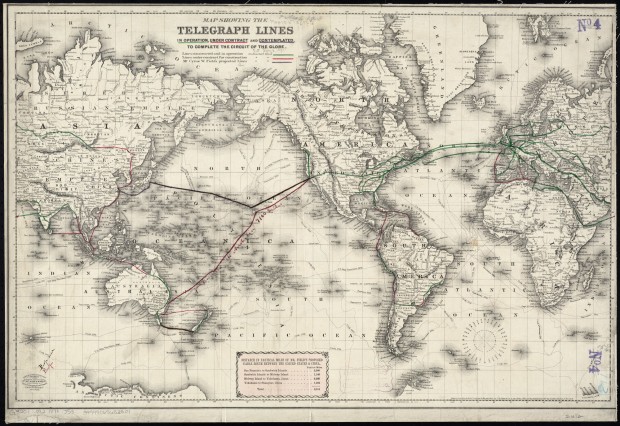An iconographic and text archive related to communication, technology and art.
☛ Boston Public Library / Norman B. Laventhal Map Center: “Carte générale des grandes communications télégraphiques du monde” (“General Map of Worldwide Telegraphic Communication”) by the International Telegraph Bureau (Bern, Switzerland), 1901. Call number: G3201.P92 1903 .B87x. A hi-res version can be downloaded at the link (7265 × 5119, 36.4MB).
• • •
From Jean-Luc Nancy’s book The Creation of the World, Or, Globalization:
Urbi et orbi: this formulation drawn from papal benediction has come to mean “everywhere and anywhere” in ordinary language. Rather than a mere shift in meaning, this is a genuine disintegration. This disintegration is not simply due to the dissolution of the religious Christian bond that (more or less) held the Western world together until around the middle of the twentieth century to which the nineteenth century effectively relinquished its certainties (history, science, conquering humanity―wether this took place with or against vestiges of Christianity). It is due to the fact that it is no longer possible to identify either a city that would be “The City”―as Rome was for so long―or an orb that would provide the contour of a world extended around this city. Even worse, it is no longer possible to identify either the city or the orb of the world in general. The city spreads and extends all the way to the point where, while it tends to cover the entire orb of the planet, it loses its properties as a city, and, of course with them, those properties that would allow it to be distinguished from a “country.” That which extends in this way is no longer properly “urban”―either from the perspective of urbanism or from that of urbanity―but megapolitical, metropolitan, or co-urbational, or else caught in the loose net of what is called “urban network.” In such a network, the city crowds, the hyperbolic accumulation of construction projects (with their concomitant demolition) and of exchanges (of movements, products, and information) spread, and the inequality and apartheid concerning the access to the urban milieu (assuming that it is a dwelling, comfort, and culture), or these exclusions from the city that for a long time has produced its own rejections and outcasts, accumulate proportionally. (tr. by François Raffoul and David Pettigrew, Albany: State University of New York Press, 2007, p. 33)
Following the recent Boston Marathon bombings, reactions of spontaneous compassion –not only officials one– were expressed in various parts of the world. On one hand, it is tempting for a moment to think that humanity has finally come together (as if it was its obvious destiny) and that “we” are one, stronger in solidarity. On the other hand, the bombing itself is the very expression of the fact that there is no such thing as a single harmonious “one”, that “we” are many and, as such, divided. Globalization is not equalization. It is possible that the very movement that allows people all over the planet to show compassion in unison is also the movement that intensifies violent confrontations. In his book La Communauté affrontée which he wrote a few weeks only after the events of September 2001, Jean-Luc Nancy opens with the following lines:
The present state of the world is not a war of civilisations. It is a civil war: it is the internal war of an enclosed city, of a civility, of an ‘urbanity’, which are in the process of fanning out to the very limits of the world […] (“The Confronted Community”, tr. by Amanda Macdonald, Postcolonial Studies, Vol. 6, No. 1, [2001]2003, p. 23)
• • •
The Norman B. Laventhal Map Center has 11 maps of telegraphic lines. Below in an even older map from 1871 showing “the telegraph lines in operation, under contract, and contemplated, to complete the circuit of the globe”. It was created by J.H. Colton & Co. for G.W. & C.B. Colton & Co. (call number: G3201.P92 1871 .J53).

More similar maps can be found at Atlantic-cable.com which is a website about the “history of the Atlantic Cable & Undersea Communications”
- By Philippe Theophanidis
- on
- ― Published in Communication, Technology
- Tagged: community, confrontation, death, globalization, humanity, Jean-Luc Nancy, map, mondialization, telegraph, terrorism, wire, world

